When you think of Venice, you may imagine gondolas, the canals, and the iconic St. Mark's Square. But what many people don't immediately recall is that Venice, Italy, is also known for its exquisite Murano glass.
The art of Murano glassmaking dates back centuries and is a defining aspect of Venetian culture.
In fact, this Murano glass is so special because it is made using unique techniques that have been passed down from generation to generation, resulting in beautiful, high-quality pieces that are highly coveted by collectors around the world.
Let's discover more about the Murano glass in Venice Italy.
Murano Glass in Venice Italy: something about its amazing history
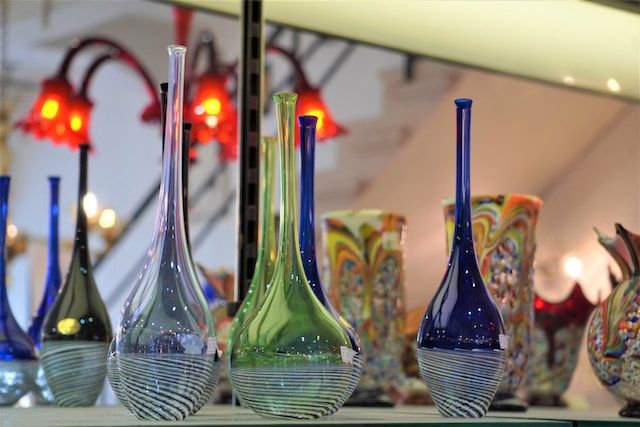
The history of Murano glass is as fascinating as the glass itself.
The first evidence of glass factories were found in the beautiful island of Torcello and dates back to the seventh and eighth century. However, it seems that the glass production started as early as the fifth century, when many people coming from Aquileia had to escape to the Venetian islands from the so-called barbarian invaders.
Anyhow, the real history of the Venetian glass begins in the thirteenth century when the Venetian Republic ordered all glassmaking to move from Venice to the nearby island of Murano.
This decision was necessary as at the very beginning most of the furnaces were localized in the area of Rialto, where most of the houses and buildings were made of wood. Can you imagine how many fires occurred at the time?
The furnaces used for glassmaking were indeed a significant fire hazard.
Moving the furnaces to Murano, the glass making techniques were also confined to the island
Like in a marketing plan ante litteram, confining the art glass in the island of Murano prevented the spread of the secrets of the techniques. No one, besides the glass makers, had to know about the process of glass making.
For this reason the glass masters were so important within the Venetian society. They had more privileges than other artisans, but they could not travel abroad without specific permission by the Republic. Moreover, if they were caught divulging secrets about the glass blowing process they could also have been sentenced to death!
Glassmaking workshops began to pop up all over the island, with each workshop specializing in a particular type of glass or technique.
Today, the glassmaking artisans of Murano continue to carry on the traditions of their ancestors.
They use the same techniques and methods that have been perfected over centuries to create beautiful pieces of glass art.
While the trade has evolved over time, the importance of skilled artisans in the creation of Murano glass remains as vital today as it was hundreds of years ago.
A look at some Murano Glass making techniques
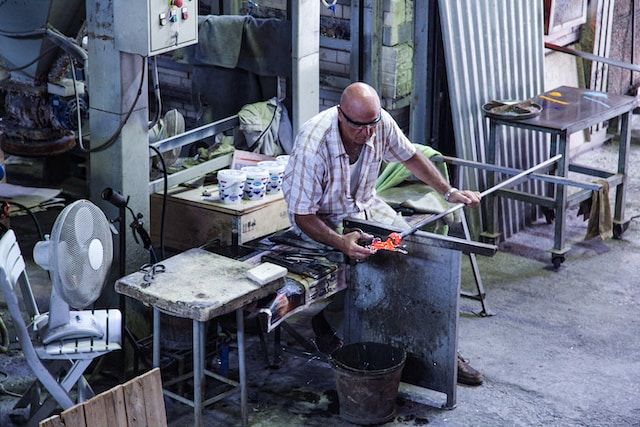
While many people are familiar with the colorful blown glass pieces that Murano is known for, there are actually many different types of Murano glass.
In fact, the Murano glass production has changed over time, with the discovery of new techniques.
Murano glassmakers also developed a range of colors and techniques, including the use of gold leaf and enamel, that were unique to their craft.
The Venetian glass production was (and still is) known for incredible Murano glass chandeliers, mirrors, cristallo and murrine.
Actually it was also very famous for the "millefiori glass" method, which involves creating intricate patterns using tiny, multi-colored glass canes.
Another popular type is murrine, which involves creating intricate patterns using slices of glass canes. Murrine pieces are made by layering and fusing multiple glass canes together, then cutting them into thin slices to create the pattern.
Mirrors are another type of Murano glass that are highly prized by collectors. Murano mirrors are often elaborately decorated with intricate patterns, and the glass used to make them is of the highest quality.
Would you like to know more about the making process?
How to make the Murano glass in Venice Italy

The process of making Murano glass is incredibly complex and involves many steps.
First, the raw materials (silica, soda, and lime) are melted in a furnace until they reach a temperature of around 1500°C.
Once the glass is melted, the glassmaker will use a long metal rod to gather a small amount of glass mixture from the furnace. They will then blow into the rod, creating a bubble of glass at the end.
The glassmaker will then use various tools to shape the glass into the desired form. Once the piece is complete, it is placed in an annealing oven to cool slowly over a period of several hours.
This helps to prevent the glass from cracking or breaking due to thermal shock.
You can actually see part of the making process joining a glass blowing tour in the island of Murano! After the tour (which is very entertaining for adults and younger people, too), you could also decide to buy your Murano glass piece!
Why is Murano glass so expensive?
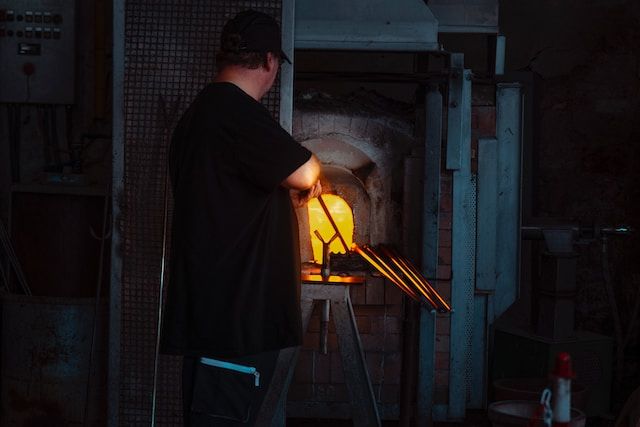
At this time of the article, you should have probably understood why Murano glass objects are so expensive. There are many reasons behind their price.
The cost of Murano glass is due to a variety of factors, including the skill required to create the glass and the high cost of raw materials.
Each piece of Murano glass is made by hand by skilled masters, often using techniques that have been passed down through their families for generations. The glass is made using high-quality silica, soda, and lime, which are expensive materials.
In addition, many pieces of Murano glass are decorated with gold or other precious metals, which adds to the overall cost.
So, is Murano glass worth the money? Indeed, it is. So many visitors coming from all over the world decide to bring home their unique pieces. What they are actually buying is not just the beautiful object, but also the history behind it, the skills of the artisans and the great quality of the glass.
How can you tell if it is real Murano glass?
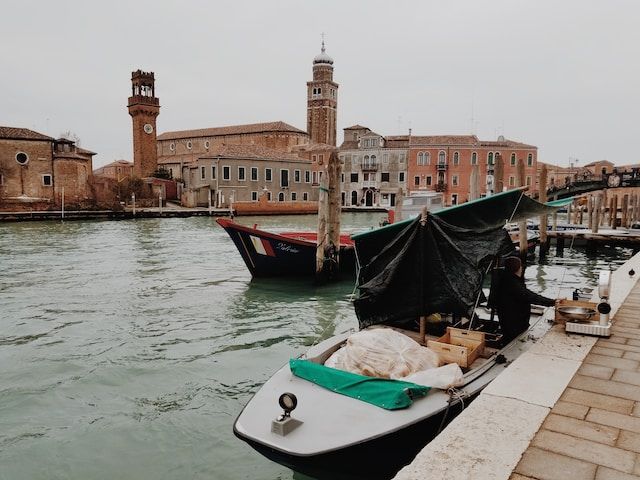
Because Murano glass is so valuable, there are many imitations on the market. Even walking through the city of Venice, you may find glass objects that are just imitations of the original Murano Glass.
To determine whether a piece of glass is authentic Murano glass, there are several things to look for.
First, check for a signature or label on the glass that identifies the artist or company that made it.
Second, look for bubbles or imperfections in the glass, which are a sign that the glass was handmade.
Third, examine the color and design of the glass. Authentic Murano glass is known for its bright, bold colors and intricate patterns.
Finally, just have a look at the price. The authentic Murano glass is generally more expensive than the copy.
How to know more about Murano glass in Venice Italy
If you're interested in learning more about Murano glass, there are plenty of resources available.
For example, in the island of Murano (Venice, Italy), there is a museum specifically dedicated to glass art.
If you visit it, you could see some of the most beautiful pieces of Murano glass in the world.
However, you can also find Murano glass in many shops and galleries in Venice. Whether you're a collector or simply appreciate the beauty of this exquisite glass, Murano glass is a must-see when visiting Venice.
Would you buy your perfect piece of Murano glass?
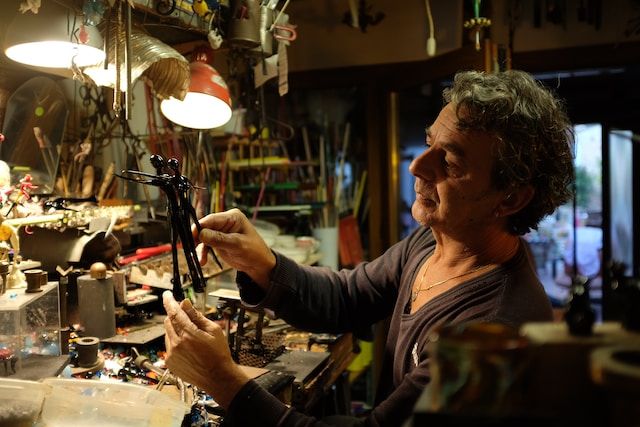
Murano glass is a truly remarkable art form that has been perfected over centuries.
From blown glass vases to intricately patterned mirrors, there are many different types of Murano glass that are highly valued by collectors around the world.
The complex process of making Murano glass by hand, using high-quality materials and unique techniques, is what makes it so special.
Whether you're a collector or simply appreciate the beauty of this exquisite glass, there is no denying that Murano glass is a true masterpiece of Venetian culture!

